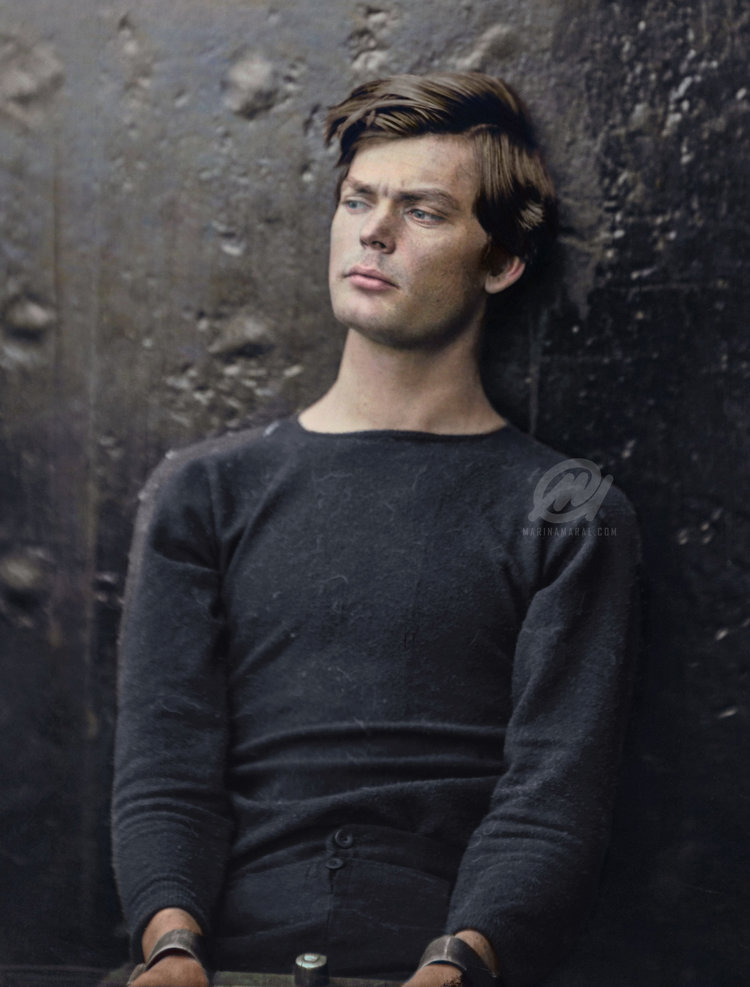Lewis Powell, also known as Lewis Payne, was one of the conspirators with John Wilkes Booth in the assassination of President Abraham Lincoln. Digital artist Marina Amaral colorized this 1865 photo by Alexander Gardner. The original is in the holdings of the Library’s Prints and Photographs Division.
Marina Amaral was studying international relations at the Pontifical Catholic University of Minas Gerais, Brazil, when she first tried her hand at digitally colorizing a historical photograph. She had no formal background in art or photography, but since childhood she had enjoyed working with Photoshop in her free time. One day, while not feeling terribly optimistic about future career prospects, she encountered a collection of colorized World War II-era photographs on the web and decided to reproduce the technique.
Transfixed, she continued to practice and improve, eventually adopting digital photo restoration and colorization as her profession. In September, she will publish “The Colour of Time: A New History of the World, 1850–1960,” a book of 200 colorized historical photos accompanied by captions by best-selling historian Dan Jones.
Amaral discovered multiple photos that will appear in the book in the Library of Congress online collections. Here she answers a few questions about her work and her use of photographs from the Library.
How do you determine which photos to colorize?
My choices are based on two important factors, above all others. First, a photo needs to be in the public domain, and it also needs to be of medium or high quality. In a way, this greatly diminishes my options, but these are two essential factors for me. There are some amazing photos that I would love to colorize, but they are protected by copyright restrictions. Beyond that, I’ll evaluate how interesting a photo is based on its subject, composition and small details that catch my attention, like the face of a person smiling at the camera. All this contributes to my final choice.

Amaral colorized this 1864 photograph from the Prints and Photographs Division by Timothy O’Sullivan. It shows a Union war council meeting in Massaponax Church, Virginia, including Gen. Ulysses Grant, Gen. George Meade, Assistant Secretary of War Charles A. Dana and others.
What is your goal in colorizing historical photos?
I strongly believe that colors have this immense power to makes us better understand that historical people and events were real. When colors are applied to the faces of people, to the buildings and streets of cities in photos taken decades ago, I believe that we can create a greater empathy and a deeper connection with what we are seeing. My goal is to offer this perspective, allowing people to see those particular scenes and people in color, as they were actually seen through the photographer’s eyes.
What kind of research do you do before beginning?
I research everything I can—military uniforms, medals, hair, skin colors. Since I’m not an expert, I count on the help of historians and people who have studied enough to be able to give me a direction to follow. They are definitely essential to my work, and I am very grateful that they are always willing to help me.
What tools and techniques do you use to achieve such life-like results?
There’s no big secret. I use basic Photoshop tools and a great deal of patience. But what helps me achieve realistic results is the fact that I’m never satisfied, and I’m always looking for something new to study and learn that might add to what I currently do. I study traditional painting techniques and principles of chemistry and physics, among other things. I’m always trying to improve.
Which photographs and collections at the Library of Congress have you used?
The Library of Congress is the best source of high-quality photos I know of. Sometimes I spend more time looking at the collections than colorizing the pictures! These collections are an extremely valuable resource for us—artists, photographers, teachers or lovers of history and photography.
Marina Amaral
Which Library photos stand out for you?
The entire Civil War Collection is absolutely amazing. I always find incredible photos there. My favorite is an 1865 picture by Alexander Gardner of Lewis Powell, also known as Lewis Payne, a conspirator with John Wilkes Booth, who assassinated President Abraham Lincoln. Another favorite is an 1864 photograph by Timothy O’Sullivan of a Union “war council” meeting in Massaponax Church, Virginia, including Gen. Ulysses Grant, Gen. George Meade, Assistant Secretary of War Charles A. Dana and others.
What has your experience been like working with the Library’s collections?
It has been amazing so far. The website is easy to use, and I always have a very enjoyable experience looking at the collections.

















